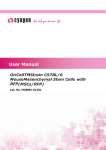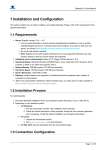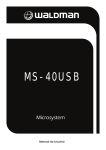Download 1745-2.4, SLC Programmable Controllers EEPROM Memory Module
Transcript
PRODUCT DA TA I yj’T5 SLC TM Programmable Controllers EEPROM Memory Module- Catalog No. 1745-MI The EEPROM Memory Module The EEPROM is a non-volatile memory in convenient modular form,for use with SLC 100 and SLC 150 Programmable Controllers. A Series B module or a Series A module having a28-pin chip must be used with the SLC 150 processor unit. The majorityof Series A modules sold in the pastmeet the 28-pin chiprequirement. Specifications ._ EEPROM Program /dentification Since EEPROM modules can be inserted in any SLC 100 or SLC 150 processor unit, it is important thatyou identify each EEPROM with the particular program it contains and the controller or controllers it is to be used with. Caution: Interchanging programs between controllerscould cause improper operation and equipment damage.You must be especially cautious when interchanging programs betweenSLC 150 and SLC 100 controllers, becauseof differences associated with certain internal addresses and other variations. Publication 1745-2.4 -October, 1987 Supersedes Publication 1745-2.4DatedAugust, 1985 40065-233-01 (C) 2 E E P R O M Memorv Module /nsta//ing the EEPROM Storing andLoading Procedures The procedurefor installing the EEPROM in the processor unit is shown in the figurebelow. IMPORTANT: Always turn off power to the processor before youinsert orremove the EEPROM. This guards against possible damage to the EEPROM and also avoids undesired CPU faults. The following paragraphs explain how to use the pocket programmer to store a processor RAM program in the EEPROM and to loada n EEPROM program in the processorRAM. If you are using the personal computer software, refer to the SLC Personal Computer Software User’s Manual (Pub. 1745-825)for further information on these procedures. 3 EEPROM Memory Module you how to use the pocket programmer to store Storing a Program in the The following steps show of the processorRAM in the EEPROM memory Memory Module (save) the contents module. If you are using an access code, it will be stored in the EEPROM. We’ll assume that the memory module is not plugged in. 1. Connect the programmer. Press MODE,6 , ENTER. Display will show SurE ? Note: You could press ENTERa second time, althoit isn’t necessary. Error code E51 will appear; you can ignore the error code and perform step 2. 2. Disconnect power fromthe processor. Insert the memory module. Restore power. 3. Press ENTER, ENTER. After a brief time, the displaywill momentarily showdonE. Any program previously stored in the memory module will be erased. 4. You can now disconnect power and remove the memory module (replace cover), or you can leave the module in place. The processor operates from the RAM only. Caution: It is important to entermode 6 before installing the memory module. Reason: If the processor were in the Run mode when you disconnect power, insert the memory module, and restore power (step 2), your programcould beautomatically erasedand replaced with the contents of the memory module. Refer to auto-load procedure on the following page. Loading the EEPROM into the Processor RAM The following steps show you how to use the pocket programmer to load (read) the contentsof the EEPROM memory module into the processor RAM. If you know that the processor is in the Run mode, you may be able to use the auto-load procedure described on Page 4. If the processoris in some other mode, follow these steps: 1. Disconnect power fromthe processor. Insert the memory module. Restore power. 2. Connect the programmer. PressMODE, 7, ENTER, ENTER.(If a n you will be requested to enter the access code is stored in the EEPROM, code after you press ENTER thesecond time.) 3. Duplication of the EEPROM contents in the RAM occurs almost instantaneously. The previous program in the RAM is automatically erased. 4. You can now disconnect power and remove the memory module (replace cover), or you can leave the module in place. The processor operates from theRAM only. 4 EEPROM Memory Module Auto-Load Procedure If you are using an SLC 100 processor unit: The auto-load procedure will load the contentsof a n EEPROM into the processor RAM without the use of the programmer. The only exception: If the EEPROM has an access code, you must use the programmer. (It doesn’t matter whether the processor has the same code as the EEPROM,a different code, or no code.) Follow these steps: 1. The processor mustbe in the Runmode initially. 2. If the processoris energized, disconnect power. Insert the EEPROM. Caution: To avoid automatically entering the Run mode when you restore power, set the AutoJMan switch to Man at this time. 3. Restore power. The EEPROM contents is automatically duplicated in the RAM. The previous program in the RAM is automatically erased. 4.When you are certainit is safe to enter the Run mode, set the AutoJMan switch to Auto. If you are using an SLC 150 processor unit: In this case, you can enter a n access code in the processorRAM to protect the stored program against unauthorized EEPROM loading. The tablebelow indicates the conditions under which the auto-load procedure will and will not function. If the auto-load is functional,follow steps 1 - 4 in the paragraph above. 5 EEPROM Memory Module Programmable Auto-Load - SLC 150 Processor With theSLC 150 processor unit, you can use address 864 in your program to automatically load the EEPROM program in the processor RAM when the processor detects a memory checksum error. Such errors are detectedif memory data is altered or lostto due capacitor back-up drain, battery back-up drain, or processor malfunction. It works like this: 1. Enter thefollowing unconditional rung as Rung 1of your program: Rung 1 /-:644 2. Enter the rest of your program and store the program in the EEPROM. This is your “back-up” program. 3. If a memory problem occurs and the processor unit detects a memory error (codes 5 thru 8), recycle power. The EEPROM program will be automatically loaded in theprocessor RAM,clearing the error. An error 6 message will bedisplayed by the pocket programmer following a n auto-load error. This error message can be cleared by using the Cancel key onthe pocket programmer or re-entering the RudModTest mode via SLC personal computer software. Important: Keep in mind that when the auto-load occurs, the I/O table data is cleared. All retentive instructions (latches, timers, counters, sequencers) willbe reset to their initial states. Editing EEPROM Programs You cannot edit the EEPROM program directly. You must first load the program into the processorRAM, if it is not already in theRAM. You then edit theRAM program and store the edited program in the EEPROM. For example, suppose an EEPROM is installed, and its contents are loaded in theRAM. You can change the program in the EEPROM as follows: 1. The RAM program is a duplicateof the EEPROM program; edit the RAM program. 2. Press MODE, 6, ENTER, ENTER. 3. The edited program is now in the EEPROM (and in RAM). the Changes not Saved in EEPROM (Error ‘Ode E52) Error code E52 tellsyou that theprocessor RAM program does not match the EEPROM program.If a n EEPROM is installed in the processor unit, this errorwill appear afteryou edit your program and attempt to enter the Run or Testmodes. This remindsyou that you should load the edited program in the EEPROM before going into the Runmode. Error code E52 canbe overridden by pressing ENTER again. Note: Error code E52 is not displayed when on-line data changes are made to the processor RAM. ALLEN-BRADLEY A ROCKWELL 1NTERNATlONAL COMPANY Industrial Control Group Milwaukee, Wisconsin 53204




















